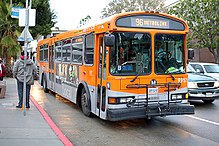Thomas Built Buses
Founded in 1916 as Perley A. Thomas Car Works, the company was renamed in 1972 to better represent its primary product lines.
[2] 1918 marked several milestones for the company, as Thomas Car Works began production of brand-new streetcars; 25 were produced.
[2] While best known from their use in New Orleans, Perley Thomas streetcars produced during the 1920s would also be utilized by communities across the United States, including Charlotte, NC; Chicago, IL; Detroit, MI; Miami, FL; Mobile, AL; New York City; Philadelphia, PA; Washington, DC, and exported as well, with Havana, Cuba as a user.
[2] In 1936, Thomas Car Works secured part of a bid to produce 500 school bus bodies for North Carolina.
As the company was only financially able to acquire materials for 200 bodies, North Carolina split the bid between Thomas and Hackney Brothers.
[2] In what is a long tradition that continues to the present day, Thomas remains the primary supplier of school buses to North Carolina.
Although not the first to construct an all-steel body, Thomas introduced one-piece roof bows, internal roll bars welded to each side of the floor/frame structure.
[2] While the design has been updated for added strength, the one-piece roof bow is in use in all school buses manufactured in North America today.
In another innovation, Thomas introduced an outward-opening entry door, designed to aid egress in emergency evacuation situations.
[2] While the war had brought school bus production to a halt, the High Point factory remained utilized in civilian capacity.
[2] Following World War II, with a rise in student populations, Thomas Car Works began to expand its sales market beyond the South, opening dealerships across the eastern half of the United States.
[2] During the decade, Thomas Car Works began exports of its product lines, establishing satellite facilities in Ecuador and Peru.
From North Carolina, bodies were shipped to South America in CKD form for final assembly on locally sourced chassis.
[2] In 1957, the Thomas Saf-T-Liner name made its first appearance, denoting updated bus bodies (with an enlarged two-piece windshield).
[2] Initially mandated in North Carolina, the device (allowing a 150-degree field of vision directly in front of the bus) would be adopted by 16 other states in only two years.
Along with extending the rub rails completely around the body, the front and rear roof caps were flattened (to accommodate 8-lamp warning systems), and the windshield was enlarged.
At the smaller end of the size scale, the Saf-T-Liner body was resized to produce the Mighty Mite, a narrow-body school bus on a shorter-wheelbase conventional chassis.
[2] In the early 1980s, Thomas launched a diversification of its product line, expanding its presence in the transit bus segment.
Alongside the small Minotour, Thomas introduced the WestCoastER, a heavy-duty variant of the Saf-T-Liner ER marketed against Crown Supercoach and Gillig Phantom school buses.
Sold only in 84 and 90-passenger configurations, the WestCoastER used heavier-duty driveline and suspension components; tandem rear axles were offered as an option.
In the late 1980s, the Saf-T-Liner product line (with the exception of the WestCoastER) adopted the MVP suffix, standing for Maneuverability, Visibility, and Protection.
To better compete with the Blue Bird TC/2000 and Ward Senator (which became the AmTran Genesis), Thomas replaced the Saf-T-Liner EF with the All Star, using an Oshkosh-produced chassis.
[8][9] Derived from the Freightliner FL60/FL70 medium-duty trucks introduced in 1995, the FS-65 chassis was paired with the Saf-T-Liner Conventional body, after several modifications (distinguished by the addition of a 4-piece windshield).
[9] The product launch marked the first completely new school bus chassis since 1980, with Freightliner becoming the first new cowled-chassis manufacturer since the 1977 withdrawal of Dodge.
In 1991, Navistar began its purchase of AmTran (completed in 1995); a year later, Blue Bird entered in a supply agreement with General Motors for conventional bus chassis.
The acquisition of Thomas by Freightliner brought financial stability to the company (something not initially afforded to the Blue Bird Corporation).
Using similar design features as the Saf-T-Liner HDX (its windshield and upper bodywork), the EFX also utilized a center-mounted Freightliner instrument panel.
The Saf-T-Liner C2e hybrid diesel-electric school bus (introduced in 2007) met with little success, leading to its withdrawal in 2013; instead, the company invested in its alternative-fuel product lines.
Named the Minotrek,[25][26] The Ford Transit cutaway-chassis school bus is designed with an aerodynamically enhanced body to optimize fuel economy.
Alongside diesel-fueled vehicles, dependent on product line, Thomas buses are also offered with alternative-fuel options, including propane, CNG, gasoline, and fully electric powertrains.












